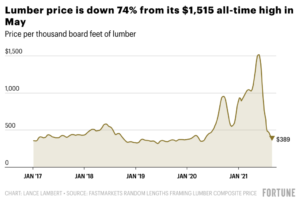Market Update
As is often the case with the media, the headlines they provide do more to terrify than clarify. What is the truth about the eviction moratorium ending and people actually getting evicted? What is the certainty about forbearance ending and foreclosures flooding the market? What is the reality about the pricing bubble popping? Are we in a normal market? Is the market really slowing? For my thoughts and a quick market update, please continue reading.
Headline #1: The end of the eviction moratorium will result in millions becoming homeless. My response, not true. People are paying rent, and they will continue to do so. Currently, 86% of renters pay their rent on time, meaning only 14% are behind. Once faced with eviction, most of these people will start paying rent to avoid becoming homeless. Additionally, there are government-sponsored programs – $46 Billion – available to tenants to ensure they can stay in their homes; only $5 Billion has been utilized so far. As state bureaucracies get out of their own way the bulk of this money will begin flowing. Additionally there is a process period, often a lengthy one, between filing for eviction and actually getting there. Additionally many people have returned to work, so making payments will not be an issue for most. In my opinion, there will not be a wave of evictions as predicted by the media.
Headline #2: When the forbearance period ends, there will be a foreclosure tsunami. My response, this also is not true. There are currently 1.78 million people in forbearance. Nearly 25% of people in forbearance continue to make their payments. Just over 28% have done loan modifications, and almost 8% have refinanced or sold their homes/paid off their loans, so people are doing what they can to remain in their homes. What is worrisome is the 15% of people who do not have a plan going forward. This means 267,000 people are at risk of foreclosure. At the height of the Great Recession, there were 3.8 million foreclosures – that is a tsunami. Right now, the delinquency rate on mortgages is at the lowest level it has been since BEFORE the pandemic. Couple this with the fact that housing prices rose nearly 14% over the last year and only 2.4% of mortgaged homes have negative equity. That puts most people in a good position related to the equity in their homes. In my opinion, people will sell and take the equity in their homes versus losing it.
Headline #3: We are in a housing bubble, and it is about to burst. My response, I’m afraid I have to disagree. Right now, our appreciation levels are below the national average – 11% versus 14%. Demand for houses remains strong, and inventory remains low, so the result is a basic economic formula of supply and demand equals rising prices. The escalating prices we saw earlier this year are tapering down, which was needed. Additionally, if you compare us to the cities we compete with for jobs and corporate relocations, we are priced lower than them. These cities are Seattle, Boston, San Jose, San Francisco, and New York. We are not in a housing bubble.
Here are the numbers that prove we are not slowing down, and in fact, we are in a robust housing market compared to “normal” years, and not the anomaly we experienced during the pandemic.
Inventory in NOVA: 2021 – 3,545 2019 – 4,283 2018 – 6,143 2017 – 6,759
Sales previous 30 day: 2021 – 3,304 2019 – 2,648 2018 – 2,448 2017 – 2,752
Month’s supply of houses: 2021 – 1.1 2019 – 1.7 2018 – 2.5 2017 – 2.5
As you can see, we are outperforming the recent “normal” years. If you are thinking about selling or buying a home, please call me to discuss your situation in more detail. Happy Fall!!
It’s a good life.
Chris
Lumber Price Falls to $399 – Down from $1,515 this Spring
by Lance Lambert | www.fortune.com
On Friday August 20th, the price of framing lumber fell to $399 per thousand board feet. “No bottom yet,” Shawn Church, editor at Fastmarkets Random Lengths, tells Fortune. Since peaking at $1,515, an all-time high, on May 28, the cash market lumber price is down a staggering 74%. Not only has the bursting lumber bubble erased all of its 2021 gains, but it has also sent prices all the way back to 2018 levels. Prior to the pandemic, the price usually ranged from $350 to $500. We’re now at the lower end of that spectrum.
“But keep in mind the cash market price is a wholesale price—not what you’d pay in the aisles of Home Depot or Lowe’s. That retail price has been slower to come down.
However, in recent weeks it is finally starting to fall. Kyle Little, COO at Sherwood Lumber, tells Fortune that by September the wholesale drop should be fully reflected on the retail side.
So what should DIYers do if they encounter two-by-fours that are still marked up? Ashley Boeckholt, cofounder of MaterialsXchange, tells Fortune they should either wait for better deals or shop around.
This historic lumber shortage was spurred by a perfect storm of factors set off during the pandemic. When COVID-19 broke out in spring 2020, sawmills cut production and
unloaded inventory in fears of a looming housing crash. The crash didn’t happen —instead, the opposite occurred. Americans rushed to Home Depot and Lowe’s to buy up materials for do-it-yourself projects, while recession-induced interest rates helped spur a housing boom. That boom, which was exacerbated by a large cohort of millennials starting to hit their peak homebuying years, dried up housing inventory and sent buyers in search of new construction. Home Improvements and construction require a lot of lumber, and mills couldn’t keep up.
What changed? DIYers got fed up with the sky-high lumber prices—which at one point were up over 300% this spring—and started to cancel their projects. That reduction on the demand side occurred as sawmills, which hoped to cash in on the exorbitant price of lumber, upped their production. Of course, reduced demand and increased supply is a recipe for a strong price correction.
Recipe Corner
Pork Tacos with Mango Salsa
www.tasteofhome.com
Yields 12 servings I Prep: 25 min. Cook: 6 hours
INGREDIENTS:
2 tablespoons lime juice
2 tablespoons white vinegar
3 tablespoons chili powder
2 teaspoons ground cumin
1-1/2 teaspoons salt
1/2 teaspoon pepper
3 cups cubed fresh pineapple
1 small red onion, coarsely chopped
2 chipotle peppers in adobo sauce
1 bottle (12 ounces) dark Mexican beer
DIRECTIONS:
- Puree first 9 ingredients in a blender; stir in beer. In a 5- or 6-qt. slow cooker, combine pork and pineapple mixture. Cook, covered, on low until pork is very tender, 6-8 hours. Stir to break up pork.
- Stir cilantro into salsa. Using a slotted spoon, serve pork mixture in tortillas; add salsa and toppings as desired.
Freeze option: Freeze cooled meat mixture and cooking juices in freezer containers. To use, partially thaw in refrigerator overnight. Heat through in a saucepan, stirring occasionally.
Enjoy!
Fall Gardening Tips and Chores
Ideas for extending the season and preparing your garden for next spring
Fall is the time to wind down and put the garden to bed. By preparing now, you can save time next spring when the growing season ramps back up. Check these things off your to-do list soon so that an unexpected early hard frost or snowfall doesn’t catch you by surprise. Then, sit back and start dreaming about next year’s garden to help you get through those darkest days of winter.
Celebrate autumn
Replace tired-looking summer annuals with mums, ornamental kale and grasses. Arrange pumpkins and gourds around the yard and home, and decorate lamp posts and arbors with dried cornstalks. Cut branches of cotoneaster and beautyberry to adorn your dining room table for festive harvest dinners, or stick the branches into year-round outdoor containers for extra seasonal color.
Extend the season
If your yard doesn’t already have one, install a fire pit or small portable fire bowl to take the chill off cool fall evenings. Place the fire pit on a patio or in a backyard area where there’s already seating. Take time to gather around with family and friends to toast marshmallows and reminisce about summer.
Bargain hunt
Check out your local nursery for end-of-the-season bargains. More expensive trees and shrubs are often discounted so that nurseries don’t have to carry extra inventory through the winter. Plant new specimens as soon as possible and keep them well-watered until they go into dormancy.
Renovate beds
Now that the weather is cooler, it’s a good time to divide and move perennials. Do this at least several weeks prior to your average first hard frost in order to give plants time to recover from transplant shock and establish new roots. Cover garden beds with several inches of mulch for extra winter protection.
Support wildlife
Rather than cutting back all of your perennials now, leave plants with seed heads, such as coneflowers, asters and ornamental grasses to provide food for your feathered friends through the harshest months. Make sure your garden includes native trees and shrubs with late-season berries, such as hawthorn, viburnum and beautyberry for seasonal color as well as additional food for wildlife.
Add sustainability
Incorporate eco-friendly practices into your fall cleanup routine. Instead of bagging fallen leaves to be hauled away, finely shred leaves with a mower and layer or work them into beds to enrich the soil. Add leftovers to the compost pile. Winterize compost by insulating with a thick layer of leaves or straw to trap the heat that is generated as organic matter breaks down. Cover with a permeable cloth to allow moisture in and to keep material from blowing away.
Think spring
By late winter, gardeners are eager for any sign of spring. Fall is the time to plant spring-blooming bulbs to fill bare spots in the perennial border, or along pathways where they can be seen up close. Plant scented flowers such as daffodils or hyacinth near your home’s front entrance where the fragrance will be most enjoyed.
Protect your pots
In colder climates, wash and store ceramic and terra cotta pots in a cool, dry place where they won’t freeze and crack. Sturdy metal, stone, fiberglass or plastic pots can be left out and used for fall and winter arrangements.
Take stock
Make a list of what worked well in the garden, and what could use fine tuning. Is a key tree getting too big? Did design elements such as hardscaping and plant combinations work together effectively? Think ahead to next year’s projects, such as building a new path, patio or water feature.
Put the patio and tools to bed
Wipe down patio furniture with mild soap and water, and store in the garage or garden shed. Scrub excess dirt from garden tools and oil the metal parts to prevent rust. Store tools in a cool, dry place. Disconnect hoses and drain for storage, and cover faucets and hose bibs with insulating material to keep them from freezing.





